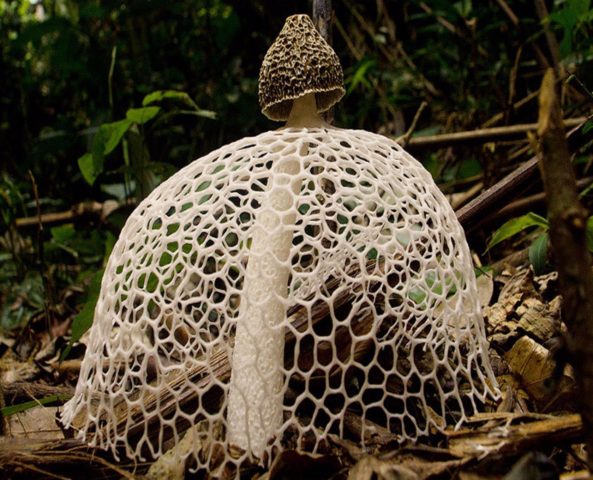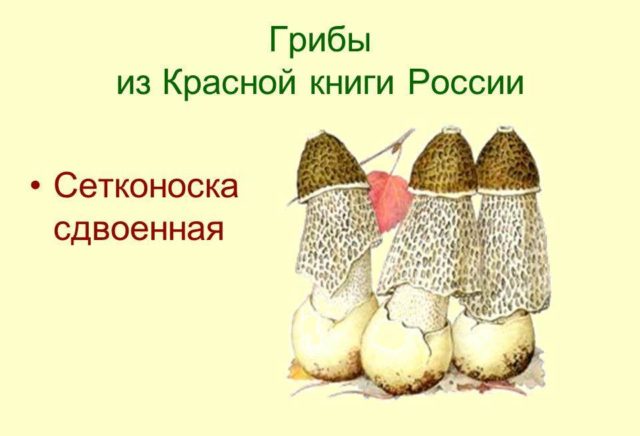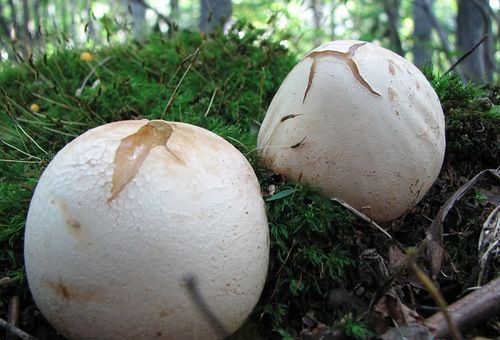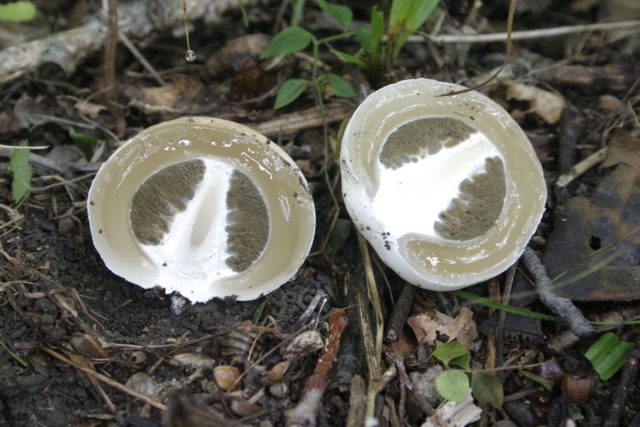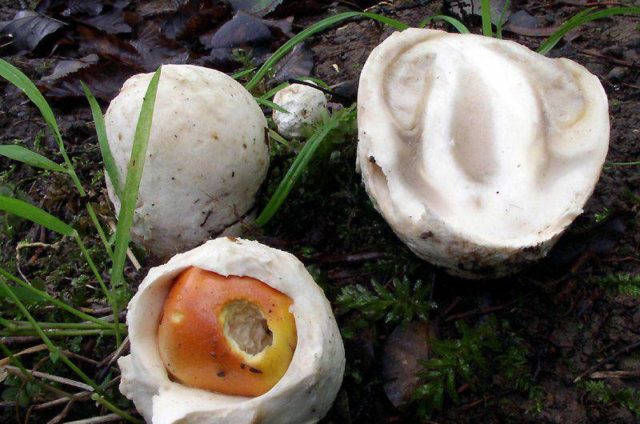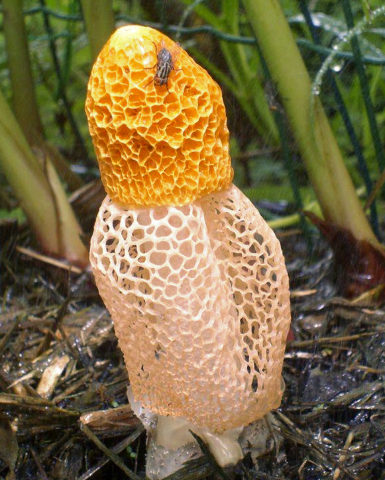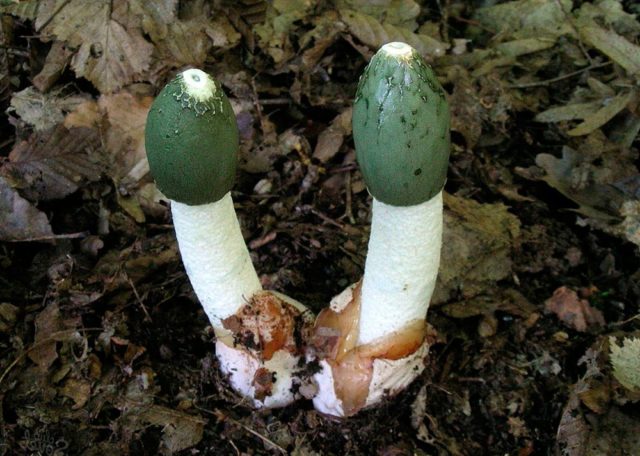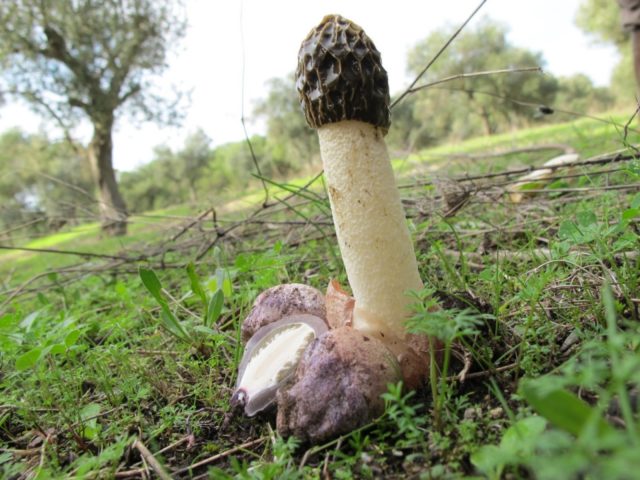Content
Double netting is an exotic in appearance conditionally edible mushroom. He, according to traditional healers, has medicinal properties and helps to activate the immune system. The product is eaten only in the stage of a young ovoid fruiting body. This mushroom is very rare in domestic forests.
What does a double mesh nose look like?
Double nets - a mushroom belonging to the Veselkovye family (Phallaceae), the Nutrievik group. Synonymous species names:
- double dictyophora;
- double phallus;
- a lady with a veil, a lady with a veil, a stinker - folk names.
The twinned fish can be found from July to September. From an ecological point of view, it is a saprotroph, that is, organic remains are needed for its development. In nature, it performs the function of a soil former and wood destructor. Spores are carried by flies. To attract these insects, it exudes a scent reminiscent of carrion.
According to the description and photo of the mushroom, given below, we can conclude about the characteristic features of the Double Setkonoska:
- Fruit egg... In the process of development, the fungus goes through two stages that are significantly different in terms of external characteristics. At the initial stage of the formation of a twinned mesh, its fruit body has an ovoid shape and is located in the ground. Coming to the surface, it reaches 60 - 80 mm in diameter, but its third part continues to remain in the soil. The egg is heavy and dense, at the base of it there are white mycelial strands. The surface of the young fruiting body is covered with a matte peridium (protective sheath). As it ripens, it takes on a yellowish brown hue. Gradually, the shell opens, and a mushroom of a special elongated shape appears from the egg.
- Hat... The fruiting body of a mature reticule is crowned with a gleba (cone-shaped cap), under which spores ripen. It has a ribbed structure and is covered with a greenish mucous membrane. Its width and height is 30x50 mm. There is a small rounded hole at the top of the cap.
- Controversy... The spores are very small (3.6x1.7 microns), oval, green with a smooth surface. They are carried mainly by flies.
- Leg... The leg of the double mesh is hollow inside and has a cylindrical shape. Its diameter is smaller at the base and cap than in the central part. The leg grows quickly to 15 - 25 cm in length and 2 - 3 cm in thickness. Its growth rate can reach 5 mm per minute. In the lower part of the leg, a shell is preserved in the form of a volva with several lobes. At first, the leg is strictly vertical. When she reaches maturity, she tends to go down.
- Induziy... This scientific name has the most characteristic part of the dictyophora - a mesh with rounded cells of an irregular shape.It hangs down in the form of a cone, covering the leg of the netnose, doubled from the cap to the middle or base. The main function of the mesh is to increase the area of the smelling surface to lure flies and dead-eating beetles.
In the early stages of the Indus, it has a bright white color, and then gradually acquires a light brown color with a light green or pinkish undertone. In the dark, it attracts nocturnal insects with a greenish glow.
Where does the double net-nose mushroom grow
The optimal conditions for the growth of the twinned mesh, or dictyophora, are created by a warm and humid environment, loose humus, covered with decomposed plant and wood remains. It grows only in deciduous and mixed forests with a predominance of deciduous trees. It is very rare in single specimens. Even less often you can find it growing in small groups of 2-6 fruiting bodies.
The populations of the twinned fish and its range of distribution are rapidly declining for as yet unexplored reasons. It is believed that this is caused by global climate change. Another probable reason is the low culture of mushroom pickers, who, upon seeing an unfamiliar fruit body, tend to destroy it.
You can meet a double netting in very limited areas:
- In Russia: in the Novosibirsk region. near the village Keys (Iskitimsky district) and with. Novobibievo (Bolotinsky district), Moscow, Belgorodst, Tomsk regions, Transbaikalia, Khabarovsk, Primorsky and Krasnoyarsk territories, in the vicinity of Tomsk, on the southern coast of Crimea, it grows in the Nikitsky Botanical Garden;
- In Central Asia (Kazakhstan, Kyrgyzstan);
- In Northern Europe (Lithuania).
Double netting is a rare mushroom, listed in the Red Book since 1984. It is not cultivated or propagated in specially created conditions. Special measures for its protection of this species have not been developed. Conservation measures consist in identifying habitats and monitoring the development of the population.
Is it possible to eat a double mesh
The double netting is a conditionally edible mushroom. Only its young fruiting bodies can be eaten while they are in the egg stage.
The lifespan of double dictyophora does not exceed 24 hours. Most often it is found when it already looks like an inedible fruiting body with an openwork mesh, exuding an unpleasant odor. It is not easy to find it in the edible stage.
Mushroom taste
The palatability of the double mesh is low. It is classified as a mushroom of low taste and consumer value and is assigned to the fourth category.
The pulp of immature dictyophora, suitable for human consumption, jelly-like consistency, odorless and tasteless. As it matures, it acquires a specific characteristic smell of carrion.
Benefits and harm to the body
According to traditional healers, the twinned net has useful properties that activate the work of the human immune system. The polysaccharides in its tissues promote the synthesis of proteins that destroy the walls of cancer cells. Special biologically active substances give the fruit body antibacterial properties. In addition, its use for medicinal purposes helps to alleviate some conditions:
- in case of disruption of the digestive system;
- tuberculosis;
- thrombophlebitis;
- hypertension;
- diseases of the joints.
In the case of an allergic reaction to mushrooms, exacerbation of diseases of the gastrointestinal tract, metabolic disorders, the use of the net-sock both for food and externally should be discarded.
False doubles
In a young form, inexperienced mushroom pickers can confuse dictyophora with mushrooms that have a spherical shape:
- with raincoat;
- with royal mushroom.
Mushrooms of the Veselka species have a similarity with the twinned setkonoskaya:
- Dictyophora bell-shaped... It does not grow in the forests of Russia and the CIS. Its habitat is the tropics of Brazil. It has a larger size and brighter color.
- Veselka ordinary... It is distinguished by the appearance of the cap and the absence of a mesh around the leg. The hat of the jersey is smooth, without a honeycomb structure and is colored green.
- Veselka Hadrian... The main difference between this mushroom is that it has no mesh and its fruit eggs are pink in color.
Collection rules
Double netting - a relic mushroom. Its collection is prohibited on the territory of the Russian Federation. If a place of its growth is found, it is necessary to report this fact to the environmental authorities.
Use
Young ovoid fruiting bodies are usually eaten raw, peeled off and seasoned with salt and spices. You can use the product with sour cream. Dictyophora double is not salted or pickled.
The fruit bodies of the nets can be fried without removing the shell. But it is believed that after heat treatment, their beneficial properties disappear.
Some gardeners are trying to grow the netnose moth in their backyards as an exotic thing. To do this, it is recommended to do this:
- To get spores, the cap is removed from the double mesh and wrapped in mulch from the forest floor.
- In the conditions of a personal plot, a hat with a layer of forest substrate is placed under the garden organic soil and periodically watered.
- The place where the cap is located must not be dug up and loosened.
Application in traditional medicine
You can find the following examples of the use of the mesh for medicinal purposes:
- A.S. Pushkin used a tincture of a mushroom for the treatment of manifestations of thrombophlebitis;
- Honore de Balzac, thanks to a double dictyophore, got rid of a stomach ulcer;
- Inhabitants of the villages located around the town of Opochka (Pskov region) often ate raw, finely chopped netkonosk with sour cream and did not get cancer.
In folk medicine, double netting is used for gout and rheumatism in the form of a tincture. To prepare it, you need to cut the raw ovoid fruiting bodies into small pieces and put them, without compacting, in a half-liter jar. Then pour the mushrooms with weak (30 - 35 0С) vodka or moonshine and leave for 21 days. At night, you can make a compress from the tincture and apply it on sore joints, wrapping it with a woolen cloth.
Conclusion
Double netting is a relic mushroom with unique characteristics, which is at the stage of extinction. It has a low taste. In folk medicine, it is used for its medicinal properties to relieve joint pain with gout and rheumatism. It is rare and is listed in the Red Book.

